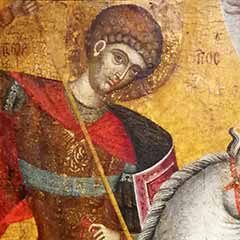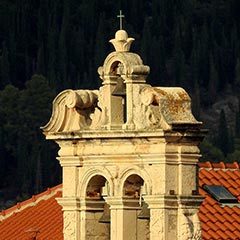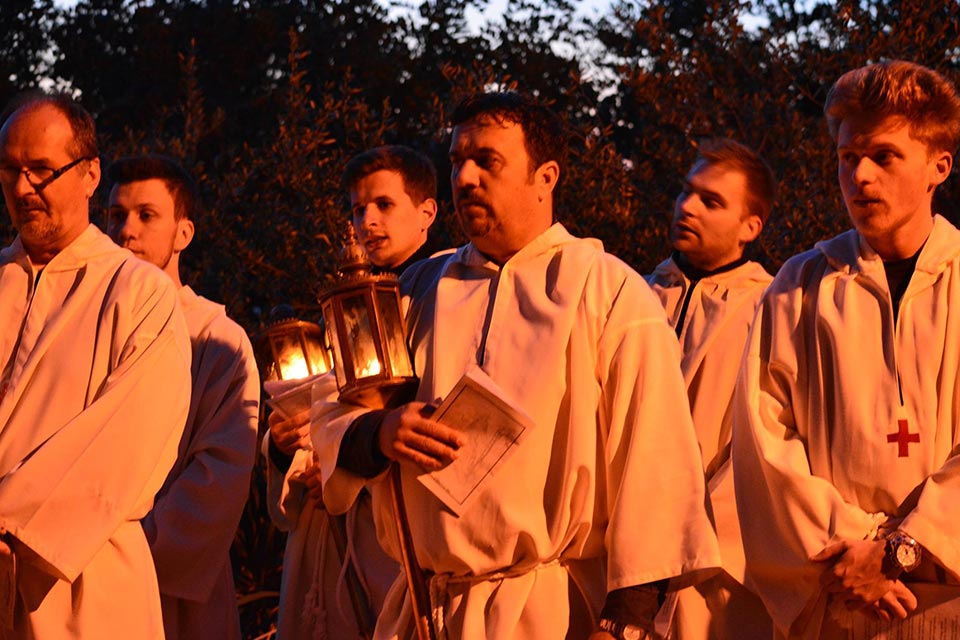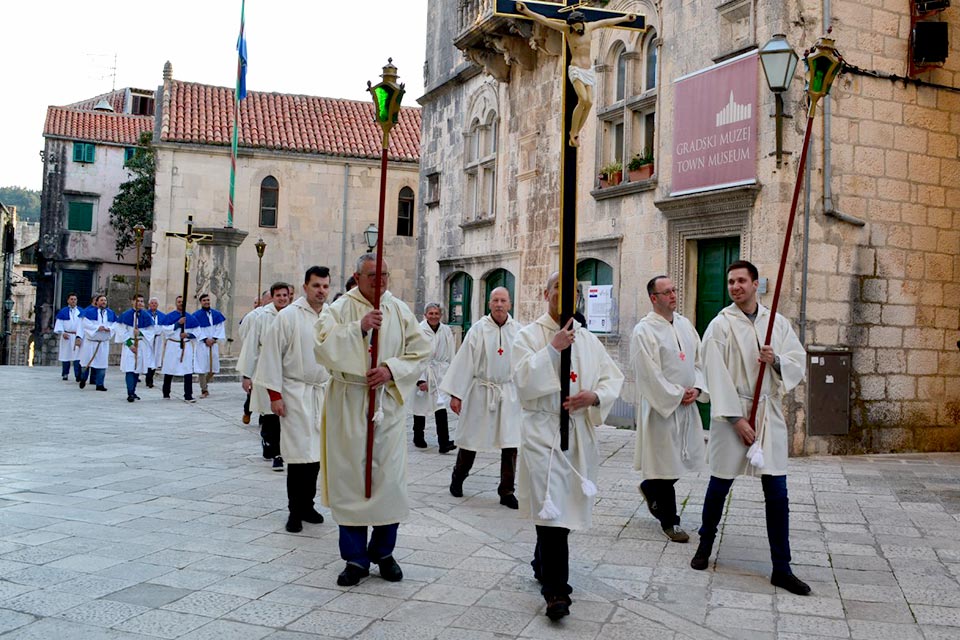
Settled in the southeastern part of medieval Korčula town, the church and confraternity of All Saints has been keeping the catholic tradition of gathering the citizens and residents of Korčula in a community for celebrating God and remembering the passion of Jesus Christ for more than 700 years. Togetherness and helping each other, especially to those more vulnerable and poor among them has been uniting the members of the oldest confraternity in town since 1301, regardless of their social status, whether they were nobility or common people.
We are all equally valuable in the eyes of God. Tradition, cultural heritage and works of art that this church and museum still preserve for us are the visible and tangible signs of christian life that has been flourishing here following the unifying rythm of liturgy throughout the year, a rythm that is unseparable from everyday life of historical and contemporary town of Korčula and its inhabitants
Old customs and tradition still treasure invaluable artworks gathered in the church and the museum collection of fraternity, and a special part of the museum inventary is the italo-crete icon collection, brought here from the island of Crete by a venetian galley during 17th centuy, the only art collection of that kind on the eastern side of Adriatic.
Enjoy in discovering this precious historical art collection and the church of All Saints in Korčula!
Museum Confraternity collection
Collection of All Saints confraternity museum is very valuable and important for Korčula’s history, because this confraternity is the oldest of all three confraternities in town, founded in 1301. by the first korčulan bishop dominican Ivan Krušić, only a year after the foundation of korčulan bishopry. Invaluable inventory that decorated the church of All Saints and the hall of confraternity situated in a nearby palace has been collected throughout the centuries of its existence.
Most famous artefacts in the museum collection are italo-cretian icons that arrived to Korčula by a venetian galley that was saving christian heritage and people fleeing from the island of Crete because of War of Candia that lasted from 1645. till 1669., a war between Ottoman Empire and Venice Republic with allies. Icons were dated from 14th till mid-17th century, and besides eleven icons there are also three painted crucifixes in the collection, the oldest one located inside the church, left of the main altar. The oldest and thematically most famous figural presentations on the icons are Christ Pantocrator and Madonna Hodegitria, both painted in 15th century in strict bysantiane icon painting style, with figural composition on the golden background. There are other icons with presentations of other saints with their attributes and names, some of them presumed to be a part of the same iconostas in one of the churches in Crete before they were brought here to Korčula.
Besides icon collection inside the hall of confraternity you can also find many valuable hand painted candles called „torci“, handwritten confraternity matricula from early 20th century, a songbook from 18th century with croatian lyrics of confraternity procession hymns that originate as early as 14th century, and a wooden voting box called „bosolo“ that was used for anonymous voting by members of confraternity. One part of bosolo was white and used for voting „pro“, and the red part was used for voting „contra“.
At the end of confraternity hall there is a big painting with a scene of Last Supper, below which you can see the examples of liturgical silverware, but the most precious silver object in the collection is a procession cross dated in 1471, a masterpiece of Dubrovnik’s goldsmith Ivan Progonović who worked in Korčula. Pay attention to an interesting filigree detail of confraternity members in adoration on the lower part of the crucifix
Working hours Museum and Church of All Saints
SUNDAY CLOSED
Group visits Contact for guides and group announcements
muzej@bssko.com
+385 (0) 20 711 306
Icons from Crete In museum collection
There are nine big and two small icons on the walls of fraternity hall, an unique collection of Crete icons that were brought here by a venetian fleet galley at the time of War of Candia (1645-1669), when venetian authorities and inhabitants retreated from that island because it was obvious that Ottomans were going to take over Crete. So in the year of 1668. one galley arrived to Korčula with its valuable cargo of cretan icons collection that was given to the fraternity of All Saints
On the left wall of fraternity hall we can see „Saint Dyonisius, Eleutherios and Onophrius“, dated in 17th century, an icon that represents three church functions- monks, bishops and ascetics. Next to it is an old cretan crucifix dated in 15th century, of which the central part is still preserved, a beautiful example of influences of venetian late gothic painting by Paolo Veneziano on Chretan icon schools.
Three icons that are dated in 15th century are „Christ Pantocrator“, „Virgin Eleousa with a donor“ and „Virgin Hodegetria“. Here we can see influences of byzantine style of Constantinople and strict themes of representing saints on a golden background. A small icon of „Virgin Passionate“ combines the motives of Hodegitria and Eleousa, and is dated in second half of 17th century.
Three icons of the same height and exquisite quality that are dated in 17th century, located near the back wall of fraternity hall are supposed to be paintings that decorated the same iconostas in one of the cretan churches. They are representations of „Saint George“, „Saint Dimitrios“ and „Saint Nicolas and Paraskeva“, all three icons are painted in an iconographic scheme established by a cretan painter Angelos Akotantos in early 15th century. On the right wall of fraternity hall we can find two other icons, both dated in 16th century, they are „St George on a horse“, and „St Anne with Virgin and Christ, flanked by St John the Baptist and St Atanasius of Alexandria“. St George is one of the most popular saints warriors that symbolises victory of good over evil.
Near the entrance of the fratenity hall we can also find a small icon of „Deisis“- popular theme that includes Christ Pantokrator seated on a throne, surrounded with a praying Virgin Mary and Saint John the Baptist. That icon is dated in 17th century, as well as a smaller painted crucifix in the same part of the fraternity hall. Another bigger painted crucifix from Crete is also part of this icon collection, that crucifix is located left of the main altar inside the church of All Saints, a beautiful masterpiece of 15th century painting with great influences of venetian late gothic style.
Church of All Saints History
Church of All Saints is located in the southeast part of Korčula town, next to the town walls. Its today appearance is the result of many alterations that happened during centuries, but that place of prayer existed even before today’s shape from the 15th century, with modifications from 16th and 17th centuries. It has a simple rectangular ground plan, and simply decorated main and side entrance with semicircular lunetes above renaissance side portals, and with two oval baroque windows that flank the main front portal. Today\’s existing belltower dates from 1750., and is considered one of the most beautiful baroque belltowers in Dalmatia.
The old belltower was demolished in a lightning strike that happened in the night of 27.8.1747. and confraternity members agreed to build a new belltower that will be taller than the buildings surrounding the church, and beautifully decorated with motives of cherub head, volutes and fruit ghirlands, motives that were preferred by local stonemasons’ workshops. There are three bells on the belltower, all of them cast in italian town Vittorio Veneto in De Poli casthouse in 1926.
The hall of confraternity is connected with the church of All Saints on the first floor level above the street by a closed bridge, and the interior of the church is richly decorated as well. Its valuable artworks are the witnesses of the long life of confraternity since 1301. The church has only one nave, and has three altars and a choir on a gallery on the first floor level, the choir space is connected with the confraternity house across the street by an open bridge with a balustrade. The invaluable artworks in the church are the altar polyptich by Blaž Jurjev from Trogir painted in 1432., with the central panel showing Pieta scene, presenting members of confraternity praying below Pieta; central altar wooden sculpture of the same Pieta theme, made by italian artist Antonio Corradini in 1723.; 15th century byzantine painted crucifiction; and the painted ceiling with 24 casettes and a central scene of coronation of Madonna that was finished in 1630.
Side altar of St Joseph with the altar painting carrying a theme of the Holy Family was finished in the beginning of 18th century, and the other side altar of Saint Anne was brought here from the Korčula cathedral in 1873., decorated with an older painting that includes St Anne, St Vincent of Ferrera and Saint Anthony of Padua. Church of All Saints is also decorated with three silver filigree work censers hanging in front of three altars; a flag of confraternity; and the front panels of a first floor choir that are decorated with paintings of Christ and 12 apostles, older work of art repainted in 19th century. Side altar of St Joseph with the altar painting carrying a theme of the Holy Family was finished in the beginning of 18th century, and the other side altar of Saint Anne was brought here from the Korčula cathedral in 1873., decorated with an older painting that includes St Anne, St Vincent of Ferrera and Saint Anthony of Padua. Church of All Saints is also decorated with three silver filigree work censers hanging in front of three altars; a flag of confraternity; and the front panels of a first floor choir that are decorated with paintings of Christ and 12 apostles, older work of art repainted in 19th century.
Confraternity of All Saints History and purpose
Confraternity of All Saints is the oldest of all three confraternities in Korčula town. It was established in 8.10.1301. during the time of the first korčulan bishop Ivan Krušić – Crosio, and it included pious lay people that gathered together celebrating Mass, adorning the Passion of Jesus Christ, and doing charity work including helping the weak and poor people of the community. Confraternity was also called The Confraternity of Good Death, because its members were in charge of burying poor people in the community, especially those who had no funds and no family, and in case of epidemy of diseases, they were also in charge of disinfection.
In the first few centuries the confraternity followed the ritual of flagellation as a penance, which was very common piety during Middle Ages, especially in Italy and in Dalmatia, so we also have medieval flagellants’ confraternities in towns of Dubrovnik, Zadar and on Rab island. Confraternity of All Saints in Korčula also had numerous members from all social statuses in town- nobility, commoners and peasants. But in the confraternity, they were all equal- brethren. Charity work was done not only because of needs of the confraternity members, but because of all town’s population that needed help. Confraternity helped and buried the poor, visited the ill, took care of the widows and orphans, and collected funds for the dowry of young girls from the poor families. Confraternity included a great amount of town’s shipbuilders and woodcarvers that have been working in Korčula’s shipyards throughout centuries, and that craft’s guild was established here in 1632. by the name of Bank of Saint Joseph, according to their patron saint who had a side altar in the Church of All Saints. Korčulan confraternity of All Saints was adjoined to roman Arch fraternity of All Saints, located in church of Santa Maria ad Martyrs known as „La Rotonda“ in 1732.
The confraternity is led by gastald, the most important person in the confraternity. He supervises all activities, leads and represents the fraternity in all events. At the time when the confraternity was an organisation of public and legal character he had great authority, and was elected for the period of one year. Today that customs have changed, and he is elected for a longer period. Besides gastald, there are two procurators who are taking care of legal estates, and two sacristans who are looking after the church and the duties connected to liturgy. Statute or matricula is the basic legal document of all confraternities, and is accepted and approved by church authorities. It is comprised of sections or capituls, where the duties of brethren and members of the board are specified, as well as the specification of confraternity’s purpose and special pieties performed by brethren during specific church holidays. General meeting or assembly and its rules are also specified in matricula, as well as asset management of confraternity’s funds and estates. General assembly is called balotacjun, coming from italian word balota, meaning the ball. Secret voting is performed with the help of a wooden voting box bosolo that has two compartments into which you would drop the ball anonymously, white compartment for „yes“ and the red compartment for „no“. Gastald also has a duty of preparing a meal called past for all the brethren once a year in the hall of confraternity, such feast is aimed to create a sense of community among the members that belong to different social statusses.
Brethren are divided in two groups- brethren of the tunic, and brethren of piety. Sisters, or consorelle are also chosen, but they have no voting rights, only a contribution in the spiritual benefits. Brethren have a duty in joining the numerous activities of confraternity, from the funerals of their members, to many processions during the liturgical year. They wear their traditional garments- white-yellowish woollen tunic with embroided litlle red cross at the hood and at the chest, and the cotton rope that is used as a belt. Most fascinating traditions of Korčula’s confraternities happen in the Holy Week before Easter, and the whole community is included in the preparations for the biggest christian holiday, so it is very recommendable to experience live all those old traditions that still live through the customs and liturgy that are passed from one generation to the next in korčulan families for centuries.
Contact us
Your opinion is important to us. If you have any questions or if you want to know something more about Confraternity of All Saints, the museum with historical collection or the church of All Saints, send us your e-mail, contact us through a form or by phone. We will be glad to answer your questions or suggestions. You can also donate funds for the Confraternity and its projects on IBAN account below.
Info
Address
Bratovština Svih Svetih
Trg svih svetih bb
20260 Korčula – HR
Bank account
Board of Confraternity
Gastald Mihovil Depolo
Gastald deputy Đuro Čehovski
Procurist Andro Denoble
Revisers Rikard Denoble and Tonči Karaman
Sacristans Joško Denoble and Mario Skelin
Members of Honorary Court
Ratko Marinović, Davor Kondenar and Mario Reić










